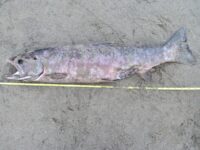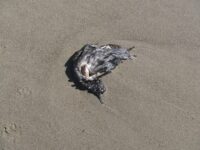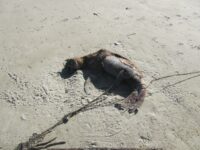Mile 94 Report
West of Laurel Lake, Lost Lake
April 5, 2012
Once again no people nor signs of people.
Report Details
Once again no people nor signs of people. Wet sand and sand below driftline quite clean and relatively narrow (fifty to one hundred yards wide). One large dead sea mammal, too decomposed to see if ears had been present, did have a short tail, probably a stllar's Sea lion. Shells, kelp/algae and small rocks below driftline. Some erosion of the foredune.
Human Activities
Number of people: 2. Number of dogs: 1. Walking or running: 3. Playing in sand: 1. Photography: 1. Beach Walk Thursday, April 5th, 2012. Blaine and I set out with our mostly-Bassett hound, LucieAnne shortly before four o’clock in the afternoon. It had been a beautiful day, sunny and warm and still. We walked down to the bank of Lower Fourmile Creek, which was still fairly high and running brown, the result of the rains that lasted most of the previous week. We slipped and stumbled about in the mud on the bank, covering ourselves with the muck, but eventually got out into the current, which was the fastest I can recall when I have been rowing in it, although much subdued from the way it was last week. The water in the creek (which is over my head, unlike the New River) was pretty cool, I would say below sixty degrees. Before we went downstream, I rowed us across the creek to find a little waterfall tumbling into the creek from the south bank. I noticed three gorse bushes growing on the South Bank. There never has been gorse on that property before as far as I know. We understand the property belongs to Bandon Biota, a Michael Keiser holding. We rowed down the creek and across the New River, which was unusually wide, and pulled up on its West Bank.I noticed a single set of canine tracks in the sand and wondered if they were left by a fox. There were no human tracks in evidence, and we had not seen anyone around the New River since we returned in early March. The dunes seemed wider than they had in the past with the distance from the New River to ocean well over a hundred yards. And we found three more gorse bushes on the West Bank, two of them over six feet across. We also found what appeared to be an Escalonia bush, a bit of puzzlement and not previously seen. I noticed a fisherman’s tackle and gear stashed next to a log on the East side of the dunes and suspected it belongs to Farmer Gibbs, a neighbor who comes over to the ocean in a kayak and fishes for perch in the surf on occasion. I have not actually seen him in several years. But the equipment looked like it was in good shape. As we made our way across the dunes, I smelled the odor of death, and when we finally crested the last and tallest dune and came in view of the Ocean, we found a large sea mammal on the sand just below the last of the European beachgrass. It looked to us like it weighed five or six hundred pounds. It was in a state of some decomposition and what I took to be its mandible and maxilla where white and exposed. I took several pictures but did not attempt any sort of necropsy. Cause of death was not apparent from a cursory visual examination. It had a short furry tail, but no ears were visible and the eyes were gone. There were no scavengers apparent.Not too far from there was an empty fifty-five gallon drum laying on the sand. This was the first time I have found one of those on the beach. The waves were small, the largest not more than three feet trough to crest, and were breaking unusually far out, some over two hundred yards from the sand. There was a lot of white foam on the beach. I have seen foam before, but not this much and in the past it has been yellow rather than white. The wind was just a breeze (I estimated less than ten miles an hour I estimated) coming from the West or West by Northwest. It was a bit cool. I figured the temperature was around sixty degrees. There were little cotton ball clouds in the blue sky with most of the clouds over the land to our East. The sand, from the edge of the dunes to the water was a bit less than one hundred yards wide, relatively narrow compared to past visits, and evenly sloped at what I estimated as ten to fifteen degrees.We made our way North. The sand below the driftline was very clean. There were occasional mussel and clam shells but no signs of crabs or jellies and perhaps a few dozen rocks, not as large as a baseball along the mile. There was a single piece of bull kelp, complete from bulb to tip, lying on the wet sand. I saw no other seaweed of any type below the driftline.But above the driftline there was lots of wood, most of it from trees as opposed to lumber. The space between the driftline and the base of the dunes was short, perhaps fifty or a hundred feet at most. And there were places were the dunes themselves had been subject to erosion by the ocean. Something we have not seen before. And there was one spot where it appeared the waves had nearly overtopped the dunes.The sand itself was neither warm nor cold under my bare feet and was fine for the most part although there was one stretch of courser sand, perhaps a hundred yards or so, where the grains were bigger than grains of table salt but smaller than peppercorns. As usual, there were no human foot prints or vehicle tracks along the entire mile. Nor any other signs of civilization aside from flotsam and jetsam. There did not appear to be an unusual amount of flotsam and jetsam. We expected more as a result of the storm season and since we figured that we were the first people on the beach in a while. We found three large red light bulbs, each with a globe about the size of a softball. There was one large chunk of foam, about the size of a basketball, and bright white. Blaine found a white porcelain bottle which we took back with us. I also saw a four foot fluorescent tube. And Blaine recovered a yellow float bearing a tag that said, “Sleep Robber”. We took that also. And I took one curious rock about the size of a softball which had many holes in it, some containing small shells.As we walked we spied three ships offshore. At least one was clearly a small fishing boat. All three were heading North paralleling the Coast and were perhaps a half mile or more offshore. At the North end of our walk we found several large snags on the sand. The largest was about thirty feet across, and we could not determine for sure whether it was a root system or the part of a tree that appears above ground. It was a tangled mass of roots or branches. We did not find the large concrete piece of dock or wharf we had found on previous visits. We saw just two birds along our walk on the beach. Both were about the size of a wren, smaller than a robin, both with white bodies and grey and white wings. The first one was walking about pecking at the dry sand above the driftline. The second one startled me, and apparently I it, as it flew up in front of me. They were not together.The only other birds we saw were three with long white necks swimming on the New River when we returned to our dinghy. They would dive under the water and one, which I timed, spent about twenty-five second before reappearing on the surface. And that one travelled over twenty feet under the surface. I think they might have been some sort of loon. We have not noticed them before. They were smaller than ducks, about the size of gulls but more slender. I should mention that the New River seems to be some sort of major flyway as we have seen all manner of avians there including Artic Swans and many geese and ducks and Bald Eagles and, perching on the trees between our house and the New River, Arctic Owls. And the bird life around our house is astounding in its variety. We made our way back to our home and arrived before six.
Concerns
Disturbances: Shorebirds moving in response to humans/dogs
Notable Wildlife
Two white birds pecking dry sand. I startled one and that one also startled me when it flew up suddenly in front of me. They were about the size of wrens, smaller than robins. Had some darker grey or black markings. Don't recall seeing them before.
Stranded Marine Mammals
Total stranded mammals: 1. Big (500 - 600 lb estimate). Perhaps a Stellar Sea Lion? (Sadly couldn't figure out how to attach photos.)
Driftline Content
Seaweeds and seagrass, Shells, Small rocks. This was below driftline.
Man-made Modifications
Gorse bushes on west bank of New River, two six feet across now. Also what appeared to be an escalonia bush.
Natural Changes
Erosion of vegetated foredune.
Actions & Comments
We removed one crab float and one bottle.
All Mile 94 Reports
Mile 94
West of Laurel Lake, Lost Lake
Accessed mile by rowing down Fourmile Creek and beaching on west side of New River.
John Hull
Mile 94
West of Laurel Lake, Lost Lake
Dead lamb and salmon on the beach.
Volunteer Trainer
Mile 94
West of Laurel Lake, Lost Lake
More people than we have ever seen on a beach walk before, two fishermen in small powered boat on new River, one fisherman walking, and what appeared to be a family of three walking South along the West Bank of the New River.
John Hull
Mile 94
West of Laurel Lake, Lost Lake
Warm day, beach wide and fairly flat, pretty clean with occasional kelp, few jellies, dozens of crab carapaces, a few broken Sand Dollars, feathers, and some other crab parts.
John Hull
Mile 94
West of Laurel Lake, Lost Lake
Saw pelican with injured wing walking on beach and a dead baby sealion and three dead birds (just partial carcasses).
John Hull
Mile 94
West of Laurel Lake, Lost Lake
Once again no people nor signs of people.
John Hull
Mile 94
West of Laurel Lake, Lost Lake
Beach sand and wet sand very clean.
John Hull




